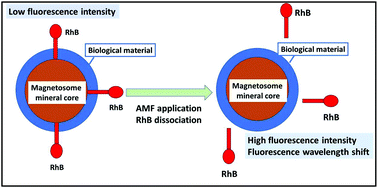Fluorescent magnetosomes for controlled and repetitive drug release under the application of an alternating magnetic field under conditions of limited temperature increase (<2.5 °C)†
Abstract
Therapeutic substances bound to nanoparticles have been shown to dissociate following excitation by various external sources of energies or chemical disturbance, resulting in controllable and efficient antitumor activity. Bioconjugation is used to produce magnetosomes associated with Rhodamine B (RhB), whose fluorescence is partially quenched by the presence of iron oxide and becomes strongly enhanced when RhB dissociates from the magnetosomes under the application of an alternating magnetic field. This novel approach enables the release of a RhB model molecule while monitoring the mechanism by fluorescence. The dissociation mechanism of RhB is highlighted by exposing a suspension of fluorescent magnetosomes to an alternating magnetic field, by magnetically isolating the supernatant of this suspension, and by showing fluorescence enhancement of the supernatant. Furthermore, to approach in vivo conditions, fluorescent magnetosomes are mixed with tissue or introduced in the mouse brain and exposed to the alternating magnetic field. Most interestingly, the percentages of RhB dissociation measured at the beginning of magnetic excitation (ΔR/δt) or 600 seconds afterwards (R600 s) are ΔR/δt ∼ 0.13% and R600 s ∼ 50% under conditions of limited temperature increases (<2.5 °C), larger values than those of ΔR/δt ∼ 0.02–0.11% and R600 s ∼ 13%, estimated for temperature increase larger than 2.5 °C. Furthermore, when magnetic excitations are repeated two to five times, the temperature increase becomes undetectable, but RhB dissociation continues to occur up to the fifth magnetic excitation. Since high heating temperatures may be damaging for tissues, this study paves the way towards the development of a safe theranostic dissociating nano-probe operating under conditions of limited temperature increase.



 Please wait while we load your content...
Please wait while we load your content...